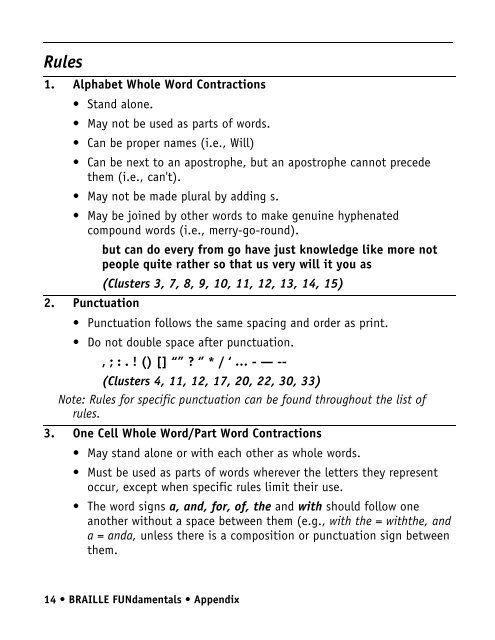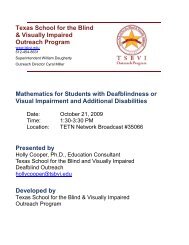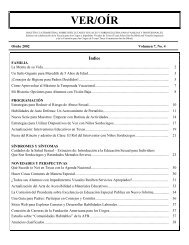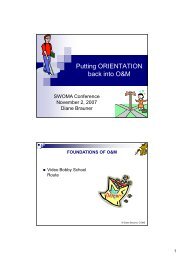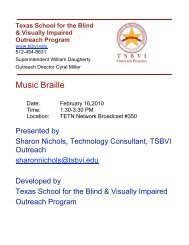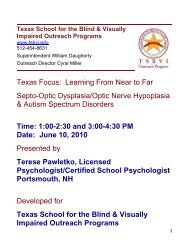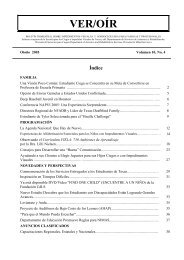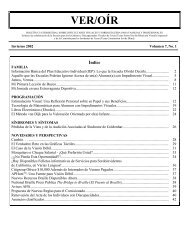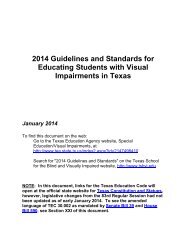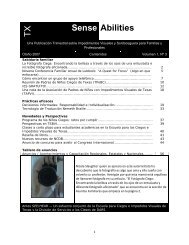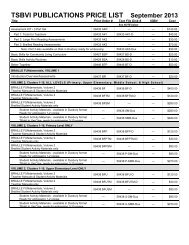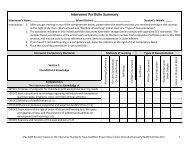Braille Rules Appendix from Braille FUNdamentals
Braille Rules Appendix from Braille FUNdamentals
Braille Rules Appendix from Braille FUNdamentals
You also want an ePaper? Increase the reach of your titles
YUMPU automatically turns print PDFs into web optimized ePapers that Google loves.
<strong>Rules</strong>1. Alphabet Whole Word Contractions• Stand alone.• May not be used as parts of words.• Can be proper names (i.e., Will)• Can be next to an apostrophe, but an apostrophe cannot precedethem (i.e., can't).• May not be made plural by adding s.• May be joined by other words to make genuine hyphenatedcompound words (i.e., merry-go-round).2. Punctuationbut can do every <strong>from</strong> go have just knowledge like more notpeople quite rather so that us very will it you as(Clusters 3, 7, 8, 9, 10, 11, 12, 13, 14, 15)• Punctuation follows the same spacing and order as print.• Do not double space after punctuation., ; : . ! () [] “” ? ‘’ * / ‘ … - — --(Clusters 4, 11, 12, 17, 20, 22, 30, 33)Note: <strong>Rules</strong> for specific punctuation can be found throughout the list ofrules.3. One Cell Whole Word/Part Word Contractions• May stand alone or with each other as whole words.• Must be used as parts of words wherever the letters they representoccur, except when specific rules limit their use.• The word signs a, and, for, of, the and with should follow oneanother without a space between them (e.g., with the = withthe, anda = anda, unless there is a composition or punctuation sign betweenthem.14 • BRAILLE <strong>FUNdamentals</strong> • <strong>Appendix</strong>
• and, for of, the and with should be used in preference to othercontractions, provided they do not waste space (e.g., the not th anded in bathed).• St may be used for abbreviations.• In proper names when the letters sh, and th are pronounced as onesound, the contractions should be used (i.e., Townshend).a, and, for, of, the, with, child, shall, this, which, out, still(Clusters 3, 24, 26, 15, 29, 31, 34, 35, 43, 48)Note: See Rule 24, General Use of Part Word Contractions and Rule 25,Preferred Contractions.4. One-Cell Whole Word/Part Word Contractions• Must be used as parts of words wherever the letters they representoccur, except when specific rules limit their use.• ble and ing must never begin a word, but may be used in the middleand end of a word and at the beginning of a line of the dividedword.• Part word signs which have no whole word meanings may becontracted when they stand alone (e.g., Ed, er, Ow!)gh, ed, er, ou, ow, st, ar, ble, ing(Clusters 15, 24, 28, 32, 34, 36, 38, 41, 52)Note: See Rule 24, General Use of Part Word Contractions and Rule 25,Preferred Contractions.BRAILLE <strong>FUNdamentals</strong> • <strong>Appendix</strong> 15
5. Dot 5 Initial Letter Contractions• May be used either as words or parts of words when they retain theiroriginal sound (e.g., timed, mothering, timer).day, ever, father, here, know, lord, mother, name, one, part,question, right, some, time, under, work, young, there,character, through, where, ought(Clusters 17, 18, 19, 20, 24, 26, 34)Note: See Rule 24, General Use of Part Word Contractions and Rule 25,Preferred Contractions.6. The Apostrophe• Is inserted before the s in plural abbreviations, numbers or letters,even though it has been omitted in print.• Should also be inserted in the expression OK'd. In such cases, theapostrophe terminates the effect of the double capital sign (e.g.,ABCs = ABC's, 1930s = 1930's, ps and qs - p's and q's, OKd = OK'd).• Follow the general rule for punctuation, (Rule 2).7. Numbers(Cluster 20)• Literary braille numbers are always the number sign plus thenumeral.• The effect of the number sign is not terminated by commas, colons,hyphens, fraction signs and decimals. However, after a space ordash, the number sign must be repeated.8. Hyphen(Clusters 21, 23)• No space should be left before or after a hyphen in a compoundword. However, a space should be left appropriately before or afterthe hyphen in a disconnected compound word (i.e., five- or sixpointedstar).• Follow the general rule for punctuation, (Rule 2).(Cluster 22)16 • BRAILLE <strong>FUNdamentals</strong> • <strong>Appendix</strong>
Note: Never call it a dash. A dash is a double hyphen and is found in Cluster55.9. Letter Sign• Is placed before a letter or letters to distinguish between the lettermeaning and a number, a word, a whole-word contraction, or ashort-form word.• Is required when:- any letter, or group of letters, immediately follows a number oris joined to it by a hyphen (i.e., 4-H Club).- a letter stands alone and is not followed by a period indicatingan abbreviation (i.e., D Day).- a combination of letters standing alone could be confused witha short-form word (i.e., line AB).- a single letter is followed by an apostrophe or is joined by ahyphen (e.g., C's, b-1, e-mail).• Is NOT required before a single capitalized or uncapitalized letterwhen:- the letter is an initial or an abbreviation followed by a periodor an oblique stroke (e.g., M.D., c/o).- a number is followed by a contraction (e.g., 1st, 4th).- the letter is preceded or followed by the apostrophe,indicating omission of letters (e.g., 'e = he, t' = to).- the letter is in or refers to an outline or listing, or is enclosedwithin punctuation marks (e.g., (f) or a) b) c).10. Short-Form Words• Should be used alone or as part of a word.• An addition may be made only if it retains its original meaning andwould not obscure recognition of the word.• An addition may be made to the short-form word provided thecombination cannot be mistaken for, or have the appearance ofanother word.BRAILLE <strong>FUNdamentals</strong> • <strong>Appendix</strong> 17
• Must not be divided by a hyphen at the end of a line, but a hyphenmay be added after the short form word if other syllables are added.• Should be used as the whole proper name only, not as a part of aproper name.• Short forms for after, blind or friend should not be used whenfollowed by a vowel, but may be used when followed by aconsonant, or a hyphen in a divided word.about, above, according, across, after, afternoon, afterward,again, against, almost, already, also, although, altogether,always, because, before, behind, below, beneath, beside,between, beyond, blind, braille, children, conceive,conceiving, could, deceive, deceiving, declare, declaring,either, first, friend, good, great, herself, him, himself,immediate, its, itself, letter, little, much, must, myself,necessary, neither, o'clock, oneself, ourselves, paid, perceive,perceiving, perhaps, quick, receive, receiving, rejoice,rejoicing, said, should, such, themselves, thyself, today,together, tomorrow, tonight, would, your, yourself, yourselves(Clusters 24, 25, 26, 28, 29, 30, 31, 33, 34, 35, 36, 40, 41,42)11. Lower Sign Contractions• Are never at the end of a word without a space, as they would beread as punctuation.• Be, enough, were, his, in, and was may be preceded by the capitaland/or italic sign. They must not be in contact with any otherletter, contractions, word or punctuation sign.• Any number of lower signs should follow on another without a spaceif one of them is in contact with a sign containing dot 1 or dot 4.• Two or more unspaced lower signs must follow one another whenthey are not in contact with an upper sign containing a dot 1 or adot 4.18 • BRAILLE <strong>FUNdamentals</strong> • <strong>Appendix</strong>
• When two or more lower-sign contractions follow one anotherwithout being in contact with an upper sign, the final lower signcontraction must not be used (i.e., "to his" must spell out "his").• To, into and by:- are unspaced <strong>from</strong> the word, abbreviation, letter, or numberwhich follows them.- begin on the next line if there is not enough room on thebraille line for it and at least the first syllable of the followingword, abbreviation, number or letter.- may be preceded and/or followed by braille composition signs.- may not be used and joined to any punctuation sign whichfollows.- do not use as parts of words, in compound words, or as propernames.• Ea and the double letter signs bb, cc, dd, ff, and gg:- must be used only when these letters occur between lettersand or contractions within a word.- must never begin or end a word.- should not be used when in contact with a hyphen orapostrophe.- must not be used where the letters are separated by a primarysyllable division.- may overlap syllable divisions which occur between a prefixand the root of a word, since to use them would not obscurerecognition (e.g., address, affect).• Be, con, and dis:- may be used only as syllables at the beginning of a word or a tthe beginning of a line in a divided word.- may be used after a hyphen in a hyphenated compound word.- may be used in names for the first syllable following Mac or Mcwhen the syllable is capitalized (i.e., McConnell).BRAILLE <strong>FUNdamentals</strong> • <strong>Appendix</strong> 19
• Com:- must not stand alone as syllables at the beginning of a line ina divided word.- may not be used in contact with a hyphen in a divided word.- can be used within an abbreviation of a word, but cannot bethe whole abbreviation.- must never be used before the apostrophe, but may follow anapostrophe.- may be used at the beginning of a word or the beginning of aline in a divided word, but need not be a syllable.- must never be used in contact with a hyphen, dash orapostrophe, even when a composition sign intervenes.- may be used after a capital and/or italic sign, unless itimmediately follows a hyphen, a dash, or an apostrophe on thesame line of writing.- when capitalized, the contraction may be used in a namefollow Mac or Mc.ea, be, bb, con, cc, dis, en, enough, to , ff, were, gg, his, in,into, was, by, com(Clusters 29, 33, 36, 39, 41, 46, 48, 49, 50, 52)Note: See Rule 24, General Use of Part Word Contractions and Rule 25,Preferred Contractions.20 • BRAILLE <strong>FUNdamentals</strong> • <strong>Appendix</strong>
12. Dots 4, 5 Initial Letter Contractions• May be used either as words or parts of words when they retain theiroriginal sound (i.e., wordy).upon, word, these, those, whose(Cluster 30)Note: See Rule 24, General Use of Part Word Contractions and Rule 25,Preferred Contractions.13. Dots 4, 5, 6 Initial Letter Contractions• May be used either as words or parts of words when they retain theiroriginal sound (e.g., spirited, worldly).cannot, had, many, spirit, world, their(Clusters 30, 39, 42)Note: See Rule 24, General Use of Part Word Contractions and Rule 25,Preferred Contractions.14. Dots 5, 6 Final Letter Contractions• Should be used in the middle or at the end of a word, or at thebeginning of a line in a divided word. They may never begin a wordnor be used alone as a whole word, nor should they be used whenpreceded by the hyphen or the apostrophe.ence, ong, ful, tion, ness, ment, ity(Cluster 32)Note: See Rule 24, General Use of Part Word Contractions and Rule 25,Preferred Contractions.BRAILLE <strong>FUNdamentals</strong> • <strong>Appendix</strong> 21
15. Dots 4, 6 Final Letter Contractions• Should be used in the middle or at the end of a word, or at thebeginning of a line in a divided word. They may never begin a wordnot be used alone as a whole word, nor should they be used whenpreceded by the hyphen or the apostrophe.ound, ance, sion, less, ount(Clusters 36, 38, 41, 42)Note: See Rule 24, General Use of Part Word Contractions and Rule 25,Preferred Contractions.16. Dot 6 Final Letter Contraction• Should be used in the middle or at the end of a word, or at thebeginning of a line in a divided word. They may never begin a wordnor be used alone as a whole word, nor should they be used whenpreceded by the hyphen or the apostrophe.ation, ally(Clusters 51, 52)Note: See Rule 24, General Use of Part Word Contractions and Rule 25,Preferred Contractions.17. Decimal Coinage• The dollar sign is placed before the number sign to indicate dollars.When writing dollars and cents, the decimal sign is used to separatethe cents <strong>from</strong> the dollars. Neither the dollar sign nor the numbersign should be repeated after the decimal sign.$ dollar sign, . decimal(Cluster 44)22 • BRAILLE <strong>FUNdamentals</strong> • <strong>Appendix</strong>
18. Fractions• Fractions are written: number sign, numerator, fraction bar,denominator.• In a mixed number, the fraction is joined to the whole number by ahyphen, and the number sign is omitted before the fraction (e.g.,85-5/16). the fraction may not be carried over to the beginning of anew line./ fraction bar(Cluster 45)19. Dash and Double Dash• When used as a mark of punctuation, no space should be left beforeor after a dash, even though the spacing or the length of the symbolmay vary in print.• A space is necessary after a dash if it ends an incomplete sentence.• A dash may begin or end a line, but the sign must not be divided.• When a dash represents an omitted word or name, a double dashshould be used and should be spaced and punctuated as a word.20. Ellipsis- dash, -- double dash(Clusters 55, 56)• Is usually 3 dots or asterisks in print indicating the omission ofwords.• Should be spaced and punctuated as a word.… ellipsis(Cluster 55)BRAILLE <strong>FUNdamentals</strong> • <strong>Appendix</strong> 23
21. Italics• Is placed before an abbreviation, word, apostrophized word,hyphenated compound word, or number to indicate that it isitalicized.• Is not to be repeated after the hyphen or apostrophe.• Should not be repeated at the beginning of the next line of adivided word or number.• Must be used in braille if they are used in print only in the followinginstances:- to indicate emphasis (i.e., If you are going to go, go.).- to show distinction only in such cases as foreign words andphrases; names of ships, pictures, book titles, publications,etc.; subject headings at the beginning of paragraphs; thedifference between silent thought and conversation; when inprint a passage is printed in italics or different typeface <strong>from</strong>that of regular text.• Should be omitted when:- quoted passages appear in both quotations and italics, unlessthe italics are required to show emphasis or distinction.- pronounciations are written in both parentheses and italics.- writings of all stage directions, settings, etc.- a letter which means a letter is written in braille preceded by aletter sign.- lists of words are printed in boldface type or italics.- word endings are separated <strong>from</strong> the root words and areprinted in italics or boldface type.• If more than three consecutive words are italicized, the first word ispreceded by the double italic sign. Where the last word of anitalicized passage is a hyphenated compound word, the closingsingle italic sign should precede the first part of the compoundword.24 • BRAILLE <strong>FUNdamentals</strong> • <strong>Appendix</strong>
• In italicized passages comprising more than one paragraph, thedouble italic sign should be repeated at the beginning of each newparagraph and the final single italic sign should precede only thelast word or the last paragraph.• The dash or ellipsis at the beginning or end of an italicized passageis not to be included in the italics.22. Brackets(Cluster 55)• When a portion of a word is enclosed in brackets, print practiceshould be followed.• Should be spaced and punctuated as a word.[] brackets(Cluster 55)23. Termination Sign• In general literature, the hyphen should be used to set apart theitalicized or capitalized part of a word (e.g., they're = they-'re,unSELFish = un-SELF-ish).• When in print a hyphen follows an italicized or capitalized part of aword, the termination sign must be inserted before the hyphen (i.e.,white-collar needs a termination sign before the collar.- termination sign(Cluster 56)24. General Use of Part-Word Contractions• Used where the letters of the contraction are in the same syllable,or would overlap a minor or incidental syllable (e.g., inform, Eden).• Must NOT be used where the usual braille form of the base wordwould be altered by the addition of a prefix or suffix (i.e., fruity).* Must NOT be used where it would violate the primary syllabledivision between a prefix or suffix and the base word (e.g., twofold,pigheaded).BRAILLE <strong>FUNdamentals</strong> • <strong>Appendix</strong> 25
• Must NOT be used where base words are joined to form anunhyphenated compound word (i.e., sweetheart).• Must NOT be used where the use of contractions would disturb thepronunciation of a diagraph or trigraph, two or more letterspronounced as one sound (e.g., Boon, sphere).• Must NOT be used where two adjoining consonants are pronouncedseparately (i.e., Wingate).• Must NOT be used where the use of a contraction would causedifficulty in pronunciation (i.e., Airedale).25. Preferred Contractions• Unless their use violates any of the principles of the rules of English<strong>Braille</strong>, where there is more than one possible choice in the use ofcontractions, the selections should be:- Preference should be given to the contractions that save thegreatest amount of space (e.g., partner not partner).- One-cell contractions should be used in preference to two-cellcontractions as parts of words (e.g., droned not droned).- Where a choice must be made between two consecutivecontractions, in order to avoid misspelling, preference shouldbe given to the contraction, which more nearly approximatescorrect pronunciation (e.g., wherever = wh er ever).26. Order of Punctuation and Composition Signs• When two or more braille punctuation marks or composition signsoccur together before a word, number or letter, they are placed inthe following order:- With Punctuation: open parenthesis, or bracket, openquotation sign, italic sign, letter sign, apostrophe, capitalsign, accent sign.- With Numbers: open parenthesis or bracket, open quotationsign, italic sign, number sign, apostrophe, decimal sign.26 • BRAILLE <strong>FUNdamentals</strong> • <strong>Appendix</strong>


